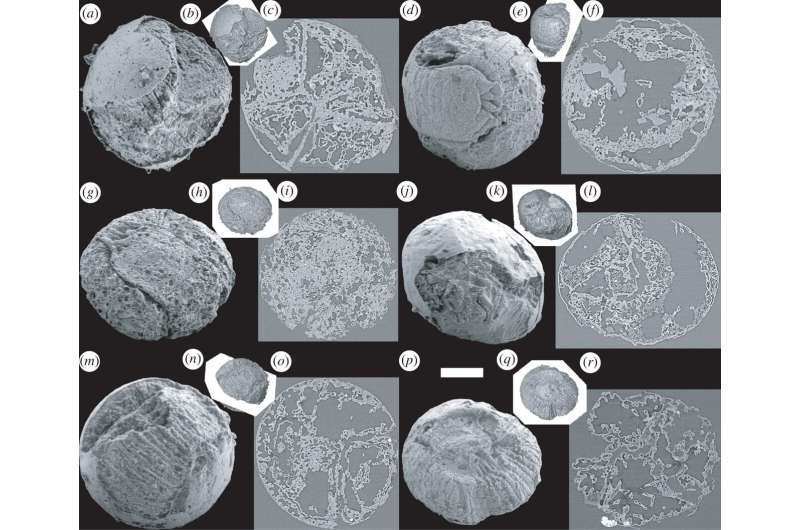SEM images, surface images and orthoslices of six scanned fossil embryo specimens of Markuelia hunanensis Dong and Donoghue, 2004. (a) SEM image of GMPKU3140; (b) surface image of (a), oriented like (a), showing the relative position of the orthoslice; (c) orthoslice of (a). (d) SEM image of GMPKU3141; (e) surface image of (d), oriented like (d), showing the relative position of the orthoslice; (f) orthoslice of (d), showing euhedral space-filling calcite crystals. (g) SEM image of GMPKU3142; (h) surface image of (g), oriented like (g), showing the relative position of the orthoslice; (i) orthoslice of (g). (j) SEM image of GMPKU2388; (k) surface image of (j), oriented like (j), showing the relative position of the orthoslice; (l) orthoslice of (j). (m) SEM image of GMPKU3143; (n) surface image of (m), oriented like (m), showing the relative position of the orthoslice; (o) orthoslice of (m). (p) SEM image of GMPKU3144; (q) surface image of (p), oriented like (p), showing the relative position of the orthoslice; (r) orthoslice of (p). Relative scale bar, 103 µm (a), 260 µm (b), 103 µm (c), 104 µm (d), 294 µm (e), 104 µm (f), 110 µm (g), 315 µm (h), 110 µm (i), 115 µm (j), 302 µm (k), 115 µm (l), 103 µm (m), 295 µm (n), 103 µm (o), 125 µm (p), 297 µm (i), 125 µm (r). Credit: Royal Society Open Science (2022). DOI: 10.1098/rsos.220115
A team of researchers at Peking University, the First Institute of Oceanography and the University of Bristol has identified a well-preserved fossilized Markuelia hunanensis embryo of the Cambrian period. In their paper published in the journal Royal Society Open Science, the group describes the condition and attributes of the fossil, including muscle tissue and brain matter.
In Hunan province in South China, scientists have been digging up fossils for many years at a limestone-rich site called Wangcun Lagerstätte—among those fossils found have been a large number of Markuelia hunanensis embryos, all dating back to the Cambrian period.
Prior research has suggested that such embryos strongly resemble adults, which has given researchers a good idea of what they looked like. In this new effort, the researchers have identified one exceptionally well-preserved fossil. Markuelia hunanensis were types of worms that lived approximately 500 million years ago, close to the same time that plants first began growing on land and when most animal groups first began to evolve. Their closest modern relatives are mud dragons.
The researchers note that soft tissue parts of ancient creatures are rarely fossilized due to their mushy nature; thus, the embryos found in China have been of great interest to scientists. Not only do they exist, but many are still in three dimensions—most other specimens at other sites have been flattened due to the way they were preserved.
In this new effort, the researchers found a specimen that was so well preserved that many of its organs could be discerned, including its doughnut-shaped brain. The researchers describe it as similar to that of a nematode.
The researchers note that their finding is the first report of fossilized nervous system material in a scalidophoran, a type of organism that includes many types of worms and arthropods. They suggest the possibility that there are many more examples of three dimensionally preserved soft tissue fossils in already discovered fossils. Their soft tissues have not been identified, they suggest, because scientists have been assuming that there could not have been any present.
More information: Xi-ping Dong et al, Internal anatomy of a fossilized embryonic stage of the Cambrian-Ordovician scalidophoran Markuelia, Royal Society Open Science (2022). DOI: 10.1098/rsos.220115
Journal information: Royal Society Open Science
© 2022 Science X Network
























